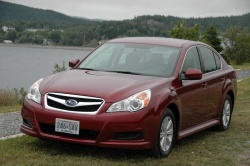  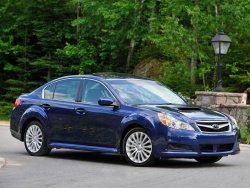 2010 Subaru Legacy PZEV, 2010 Subaru Legacy 2.5i Limited, 2011 Subaru Legacy. Click image to enlarge |
Review by Justin Pritchard
Vehicle Type: Sedan
History/Description: For model-year 2010, Subaru launched a new Legacy range that was bigger, chubbier, softer and more comfortable than the one it replaced. Though some driving enthusiasts fond of the previous-generation Legacy’s agile handling and smaller size were left out in the cold, the new-generation Legacy aimed to hit all the right areas to help put it on the radar of shoppers after a sensible Japanese family sedan: less sporty and agile, and more roomy, comfortable and refined.
Subaru officials refer to the Canadian intermediate car segment as a bank vault. Fierce loyalty, brand perceptions and intense competition make it a tough place to enter, but one that’s rewarding once inside. After 20 years in existence, this generation Legacy would aim to storm that so-called bank vault with more features, more affordable pricing and more space.
Legacy, of course, packed standard AWD on each and every model sold. Shoppers can look for features like voice-activated GPS navigation, a back-up camera system, Bluetooth phone interface and streaming Bluetooth audio. There’s a media hub for iPod fanatics, as well as an available Harman/Kardon stereo system on higher grade models.
Standard is a tilt/telescopic steering wheel with built-in audio and cruise controls, as well as a split-folding rear seat with armrest. Subaru also installed four-wheel disc brakes with ABS and Brake Assist on all models, alongside a life-saving Vehicle Dynamics Control (VDC) system to help drivers stay in control at all times.
Engines / Trim: The standard 2.5L Boxer engine was revised for reduced internal friction and lighter overall weight. At launch, it created 170 horsepower, the same as the outgoing model, but offered improved performance via the hardware attached to it—namely a new ‘Lineartronic’ Continuously Variable Transmission (CVT) in place of an automatic and a six-speed manual for shoppers who preferred to shift their own gears.
Models designated 2.5 GT get a turbocharged version of the 2.5L Boxer engine with 265 horsepower. This sporty Legacy variant only came with a six-speed stick. The Legacy 3.6R got a flat-six Boxer engine good for 256 horsepower, which came only with a five-speed, paddle-shift automatic. Where the 2.5GT was the hot rod of the Legacy lineup, the 3.6R was more the luxury touring flagship.
Models with the PZEV designation build on the standard four-cylinder Legacy and add several implements to eliminate evaporative emissions and achieve this super-clean emissions designation.
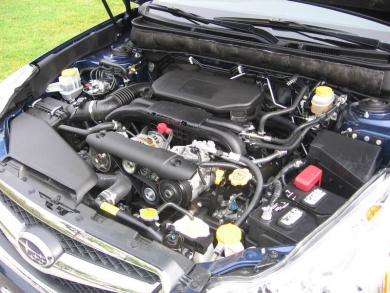 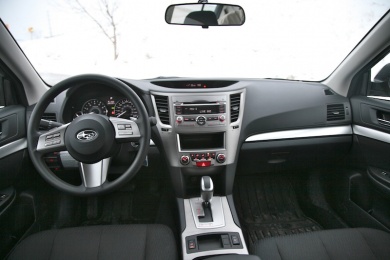 Subaru Legacy, 2010–2014. Click image to enlarge |
What Owners Like: Legacy owners taking to the web to share their ownership experiences typically talk about great wintertime handling, appreciable handling characteristics, sizing, and an all-around feel of planted confidence on virtually any road in virtually any weather. Some owners call the Legacy the perfect mix of SUV confidence and a car-like drive. Comfort is rated well, and on models with the standard four-cylinder, fuel economy is too. Further, many owners gravitated towards their Legacy sedans on account of Subaru’s gleaming reputation for residual value, safety and durability.
What Owners Dislike: Typical owner complaints centre around a less-than-impressive standard stereo system, wind and road noise at speed, and interior finish quality and materials that fall behind the competition. Performance from four-cylinder non-turbo models is said to be adequate and nothing more, which is expected.
Here are some Legacy owner reviews from www.autoTRADER.ca
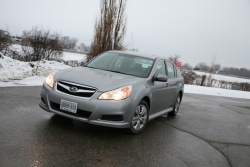 Subaru Legacy, 2010–2014. Click image to enlarge |
The Test Drive: Though Subaru has a reputation for building some solid and reliable cars, maintenance remains key when it comes to long-term durability. As such, shoppers are advised to seek out a used Legacy that’s available with documentation proving that all fluid changes, servicing requirements and tune-up work is up to date. Especially in an older or higher mileage example, a full fluid change including transmission, differentials, brake fluid and coolant, should be carried out for maximum peace of mind if service records aren’t available.
Outside, check for proper operation of the headlamps and taillights, as some owners have reported frequent bulb failure. The problem might stem from a light sensor circuit, or a wonky alternator that creates voltage spikes. Some have had luck replacing the light sensor with a revised unit that Subaru started installing from 2013 and on.











